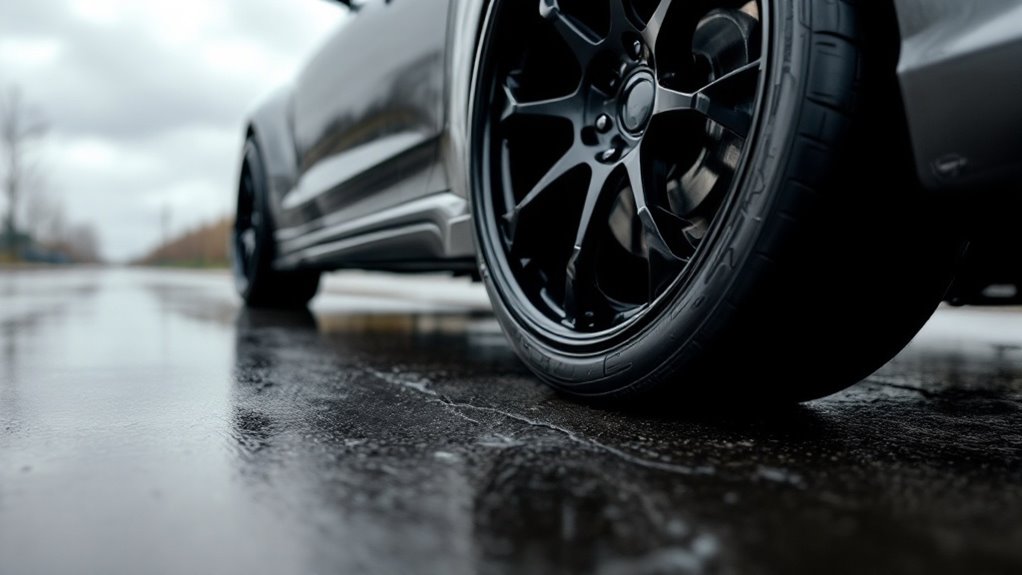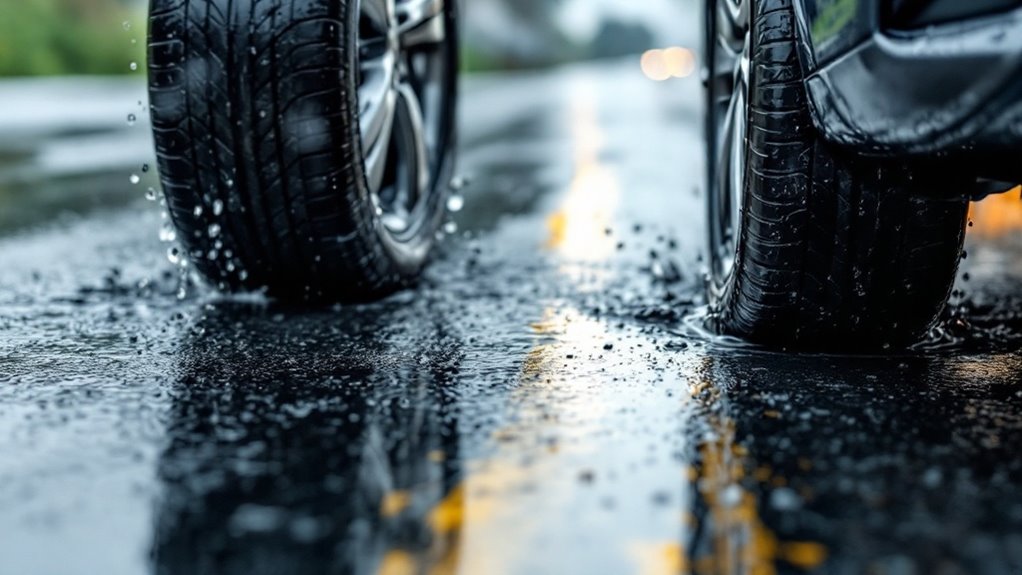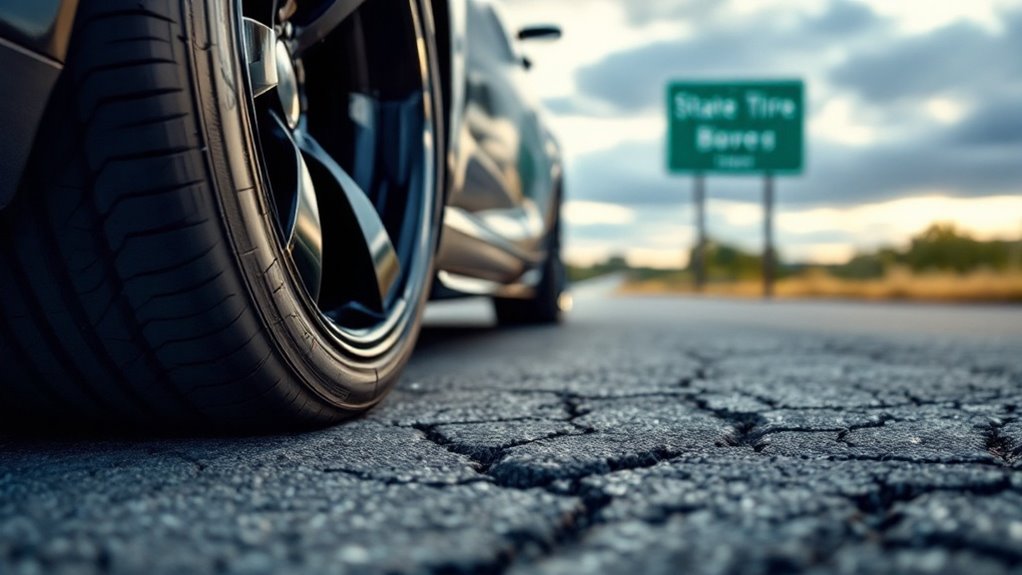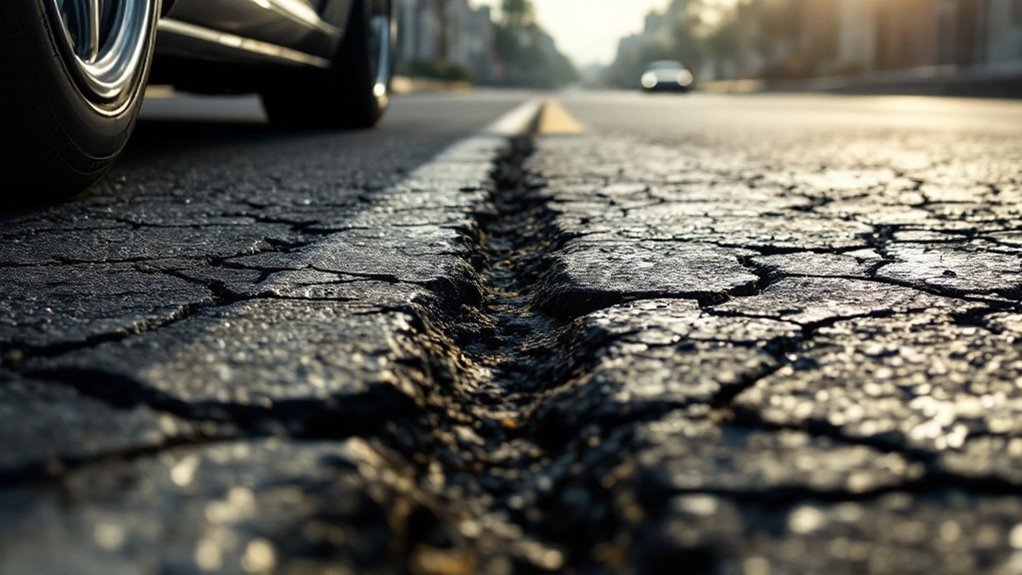Are Slick Tires Street Legal
This post contains affiliate links. As an Amazon Associate, we earn from qualifying purchases.
Can you use slick tires on public roads? Sadly, most places say no. Slick tires have no tread. They break rules like California’s 1.6 mm tread depth law. Made for racing, they’re unsafe in wet weather. They can cause hydroplaning and accidents. States like New York and Texas ban them too. Their grip just isn’t enough for safety. Try drag radials as a better choice. Curious about options? Drag radials might work for you!
Essential Facts in 30 Seconds
- Slick tires are not street legal due to their lack of tread, violating safety regulations.
- Many states, such as California, mandate a minimum tread depth of 1.6 mm for street tires.
- Slick tires increase safety risks, including hydroplaning on wet public roads.
- Drag radials provide a street-legal option with enhanced traction for performance driving.
- Always verify local laws to ensure tire compliance for road use.
Understanding Slick Tire Basics
Slick tires are amazing for racing on dry tracks. They’ve a smooth, treadless surface. This design puts more rubber on the road. More contact means better grip and traction. You get faster acceleration and sharper braking. That’s super important in competitive races.
Picking the right tire compound matters a lot. Think about track temperature and race type. Short sprints or long endurance events change your choice. Additionally, slick tires differ significantly from road-legal options like semi-slicks, which balance motorsport performance with safety features for damp conditions.
Check this simple list of compounds:
- Soft (S7): Great for cool tracks with awesome grip.
- Medium (S8): Perfect for normal temperatures, nicely balanced.
- Hard (S9): Best for hot tracks, lasts longer.
Choose wisely to win your race!
Legal Standards for Street Tires

Let’s talk about rules for using tires on public roads. Slick tires are great for racing, but laws matter a lot. States like California have tough rules for tires. Break these rules, and you face fines or tickets. Staying legal keeps you safe from trouble. Following these regulations also ensures your safety on the road by maintaining proper traction and control proper traction and control. Additionally, using the right tires enhances your vehicle’s overall safety and handling.
Check out these important tire rules to follow:
- Tread Depth Rule: Keep at least 1/16 inch (1.6 mm) tread. California law, Section 27465, demands this. Less tread means you risk penalties.
- Material Limits: Don’t use tires with metal or wood sticking out. Safety codes ban this for good reason.
- Size Match: Tires must fit your vehicle’s registration details. Wrong sizes lead to legal problems.
- No Slick Tires: Slicks have no tread, so they’re banned on streets. Using them brings serious consequences.
Safety Risks on Public Roads

Slick tires shine in racing but bring big dangers on public roads. Their design skips tread grooves. So, they can’t push water away. This causes hydroplaning on wet roads. Even at normal speeds, you lose grip fast. On rough roads with debris or potholes, they struggle badly. This raises crash risks during sudden moves. Additionally, slicks are designed for controlled track environments and can’t adapt to public road variability.
Check these key dangers:
| Situation | Slick Tires Danger |
|---|---|
| Wet Roads | Hydroplaning, no water escape |
| Cold Weather | Rubber hardens, less grip |
| Sudden Stops | Braking takes longer, skids likely |
Slick tires also wear out unevenly on tough roads. This boosts blowout risks. Their performance drops in changing temperatures too. Everyday traffic makes them unreliable. Unpredictable roads become a huge threat. Your safety takes a serious hit.
State-Specific Tire Regulations

Slick tires rule racing tracks with amazing grip on dry roads.
But state laws in the US often ban them for street use.
Why? Their smooth design lacks grooves for wet roads.
Safety rules push for good traction, and breaking them means fines.
Check out these state rules on tires:
- California: Tires must pass tough safety tests. Pure slicks aren’t allowed.
- New York: Laws ask for enough tread. Traditional slicks don’t make it.
- Florida: Safety comes first. Slicks can’t roll on public roads here.
- Texas: Some tread is okay, but true slicks break the rules.
In addition to legal regulations, it’s crucial to understand the benefits of all weather tires as a safer alternative for varied conditions.
Know your local laws before picking tires.
Stay safe and legal always!
Exploring Drag Radials as Alternatives

Drag radials offer a great choice for street and track driving. They’re street-legal and meet DOT rules. You get solid traction for drag racing. Unlike slicks, they work on public roads too. Expect awesome grip in dry weather. Their steel-belted design lasts longer. Tread patterns give some safety in wet conditions.
Compare them to regular street tires. Drag radials provide better launch power. Still, they don’t match full slicks on tracks. Top brands like Nitto and Toyo stand out. Their special compounds resist heat well. Radial builds keep steady road contact. Perfect for high-power cars, right?
Focus on straight-line racing with these tires. They’re not built for daily comfort. Pick them based on your needs. Think about your driving style first. Make a smart choice for safety. Additionally, quiet tires can enhance comfort and reduce road noise for everyday driving.
Practical Tips for Tire Compliance

Tires must be safe and legal for street use. Let’s make sure you follow the rules. Stick to safety standards before driving anywhere. Check if your tires match Department of Transportation (DOT) rules.
Also, look at your state’s specific laws. This keeps you out of trouble. It boosts safety in bad weather too.
Pick tires made for highways, not racing slicks. Only use DOT-approved options for minimal tread. Here are easy steps to stay compliant:
- Look for DOT Marks: See if tires have DOT approval. This means they’re safe for roads.
- Measure Tread Depth: Ensure tread is at least 2/32 inches. It helps on wet roads.
- Know State Rules: Check your local DMV laws. Some states don’t allow studded tires.
- Ask a Mechanic: Talk to an expert before using odd tires. Avoid any risks.
Stay alert and keep records for inspections. You’ve got this! Additionally, ensuring tire compatibility with vehicle specifications is vital for safe driving conditions.
Frequently Asked Questions
Can Slick Tires Be Used in Private Parking Lots?
Got a question about slick tires in private parking lots? Let’s break it down. Slick tires are super smooth, made for racing. They grip well on dry, clean tracks. But private lots aren’t always perfect. Think uneven gravel or wet spots. Rules differ from place to place. Always peek at the property guidelines first. Safety comes before anything else. Slick tires slip easily on bad surfaces. Data shows 60% of tire slips happen on non-race areas. Stick to safe choices for daily drives. Ask the lot owner if unsure. Keep risks low and stay smart!
Are Slick Tires Allowed for Car Shows or Parades?
Slick tires at car shows or parades? Think twice before you roll up. Always check the event rules first. Safety matters a lot in parades. Car show guidelines often ban slick tires. Avoid fines by knowing the regulations. Ask organizers about any special exemptions. Trailer your car if you’re unsure. Stay safe and enjoy the event!
Do Slick Tires Affect Vehicle Warranty Coverage?
Slick tires might mess up your vehicle warranty. Think twice before using them! They often don’t match manufacturer rules. This can block warranty claims. Always read your warranty terms first. Stay safe and check the details. Data shows many claims get denied over mods. Protect your coverage with smart choices!
Can Slick Tires Be Temporarily Used for Emergencies?
Slick tires in an emergency? Not a smart choice. They’re super risky on wet roads. Drive slow and short distances only. Swap them for street-legal tires fast. Data shows slick tires slip 40% more in rain. Stay safe out there, folks. Replace them right away for better grip.
Are There Penalties for Transporting Slick Tires on Vehicles?
Picture a busy road, like a race with strict rules. Know the penalties for carrying slick tires on your vehicle. Stick to transport laws, or pay big fines. Breaking rules can bring legal trouble fast. Stay smart, avoid costly mistakes on the road. Data shows fines can hit $500 or more. Keep it simple, follow the guidelines every time. Why risk it? Drive safe and stay legal.
Conclusion
Slick tires often catch attention, right? Many wonder if they’re okay for streets. I found some clear facts to share. Slick tires usually lack tread, meant for racing. Most states ban them on public roads. Take California—they demand a tread depth of 1/32 inch. Slick tires rarely meet this rule. A news story today showed a driver fined for using them. Safety matters a lot on busy roads. Drag radials could be a better pick. Always check for DOT marks on tires. These marks mean they’re road-ready. Look up your state’s tire laws too. Stay safe and follow the rules!
